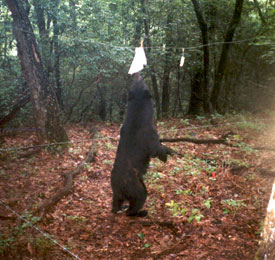Effectiveness of DNA Sampling to Monitor Black Bear Abundance in the Southern Appalachians
In 1976, state and federal biologist from Georgia, North Carolina, South Carolina, and Tennessee formed what is formally known as the Southern Appalachian Black Bear Study Group (SABBSG) to share data and develop consistent techniques for monitoring the regional black bear population (Ursus americanus). Over the years, participating agencies have consistently identified the need for an accurate population estimate for the region and the ability to track population trends over time. Conventional mark-recapture techniques based on capture and release have been used to estimate bear populations in smaller study areas but are costly, labor intensive, logistically difficult to conduct, and often provide population estimates with relatively low precision and accuracy. A relatively new technique is to "mark" and recapture animals based on DNA collected from hair samples. This technique has advantages over live trapping, including increased capture probability, tag permanency, reduced bias, and decreased intrusiveness (Woods et al. 1999, Mills et al. 2000). However, as with any populations estimation technique, DNA sampling requires and investment of time and resources, and its feasibility and optimal sampling regimes should be established before a full-scale monitoring program can be put into place. Therefore, we conducted a pilot study to determine the feasibility of DNA sampling for black bear population estimation in the southern Appalachians.

The following Adobe PDF file Effectiveness of DNA Sampling to Monitor Black Bear Abundance in the Southern Appalachians is a poster that explains the study and is available for information purposes. Adobe® Reader® is required to open the file and is available as a free download from the Adobe® Web site.
For further information on the study please contact one of the following:
Katie E. Settlage
Department of Forestry
Wildlife and Fisheries
University of Tennessee
Frank T. VanManen
Joseph D. Clark
Tim King
US Geological Survey
Leetown Science Center
David Gregory
Georgia Department of Natural Resources
Mark Jones
North Carolina Wildlife Resources Commission
Skip Still
South Carolina Department of Natural Resources
Bill Stiver
National Park Service
Gary Peters
U.S. Forest Service
